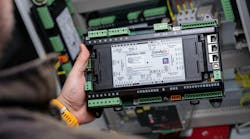NTT’s Adams: Tremendous Demand is Driving Company’s Expansion in Virginia
NTT Global Data Centers Americas (GDCA) is riding a wave of demand for digital services, which is prompting the company to expand its infrastructure offerings in strategic markets, especially Northern Virginia.
“We’ve seen a tremendous, tremendous uptick in our business,” said Doug Adams, the President and CEO of NTT GDCA. “Where we used to sell 4 megawatts or 8 megawatts at a time to the large enterprise or hyperscaler, we’re literally selling entire buildings now.”
Adams sat down with Data Center Frontier recently at the company’s campus in Data Center Alley in Ashburn, Virginia, which has been a key region for the growth of cloud computing. The super-sized appetite of hyperscale customers has NTT planning ahead for growth with “land banking” strategies, which is why the company recently acquired more than 100 acres of land in Prince William County, about 25 miles south of GDCA’s Ashburn campus.
“We’re seeing that things are starting to push out (of Ashburn) and the next big market, we believe, is Prince William,” said Adams, who said this expansion strategy will be seen in other markets as well. “We are in the process right now of looking all across the U.S. and buying second and third campuses so that we can continue to grow in those markets, which is very important for our hyperscale, enterprise and our retail clients,” said Adams.
Here’s the video of our conversation with Doug Adams, produced with NTT Global Data Centers Americas:
Here’s a full transcript of DCF’s conversation with Doug Adams:
Rich Miller, Data Center Frontier: Today we’re talking about the changes that we’re seeing in the dynamic global data center and cloud computing market. My guest is Doug Adams, the CEO of NTT Global Data Centers Americas. There’s a big growth story going on in data centers and cloud computing. The really dominant players seem to be driving the market. What’s been changing about hyperscale computing and how is that altering the business?
Doug Adams, President and CEO of NTT GDCA: Over the last five years, we’ve seen this strong push towards businesses pushing to digitize all of their assets. In addition to that, because of COVID, we’ve seen an acceleration of the massive adoption of the cloud. Those cloud providers are trying to keep up with demand, and the demand is so high that they’re coming to all of the private data center providers like GDC, and they’re asking us to help extend their portfolios. So as they move into new markets and they create new availability zones, they look to us to do that. And so we’ve seen a tremendous, tremendous uptick in our business.
Rich Miller: Let’s talk about the size of the requirements. It’s not just that there’s more business, it’s that the data centers themselves are getting larger, as are the campuses that house them. What’s driving that trend?
Doug Adams: Large companies are moving away from paper assets and moving to everything being digitized and electronic. For instance, in the health industry, if you look at what it takes for a dataset to do an AI of X-ray or something of that nature, it’s literally tens of thousands of x-rays that need to be uploaded into their clouds and analyzed. That’s causing a huge amount of compute needs. The second thing is really the fact that COVID and our new lifestyles and work from home are causing the clouds to explode in use. Where we used to sell 4 megawatts or 8 megawatts at a time to the large enterprise or hyperscaler, we’re literally selling entire buildings now.
Rich Miller: It’s pretty amazing how COVID has accelerated so many of the digitalization trends that we were already seeing. That’s particularly big business in a place like Ashburn, Virginia, where we’re sitting today. Why is Northern Virginia such an important market and what are the trends that you see going on here?
Doug Adams: Northern Virginia is actually one of the largest global markets, with huge fiber trunks coming in and out of this market and going to Europe and all across the US. There’s a heavy concentration of content providers here, and I think those two things are really causing this market to explode. But now we’re seeing that things are starting to push out (of Ashburn) and the next big market, we believe, is Prince William. That’s why we just purchased 103 acres there. And if you look at that piece of land, our neighbors to the right and the left of us are large hyperscalers, and large providers like us that have also put a similar bet on that market.
An aerial view of the Ashburn campus for NTT Global Data Centers Americas. (Photo: NTT GDCA)
Rich Miller: There’s an old saying about land that they’re ‘not making any more of it,’ and that seems to be the issue here. There’s a term called land banking about finding sites for a future growth, future capacity. Why is that important and how is NTT thinking about that?
Doug Adams: NTT is a $100 billion company. I think they’re a top 50 global company, and that capital and that capitalization that they bring is huge for us. It gives us the ability to strategically land bank in markets where other providers aren’t able to. We’re in the process right now of looking all across the U.S. and buying second and third campuses (in cities with existing NTT GDCA campuses) so that we can continue to grow in those markets, which is very important for our hyperscale, our enterprise and our retail clients. They all want to ensure that over time they have the ability to grow within our data center portfolio as we have the land and we have the capital and the wherewithal to build.
Rich Miller: Power is the lifeblood of any data center. What does the outlook and availability look like for power and how does that shape how you approach the business?
Doug Adams: We actually have an asset management group that has a whole power division that works on what our future for power looks like. We work closely with people like Dominion Energy (in Virginia). In Texas, we work with Garland Power Light, and we plan out and strategically look at what our forward buys and what our pricing will look like on power. We’re also, of course, looking at wind farms and solar farms, and we’re looking to how we can have a more green profile.
Rich Miller: One of the most important questions in the data center industry is sustainable power. How is NTT approaching sustainability?
Doug Adams: If you look at the three primary objectives that Shimada-san (NTT President Akira Shimada) has come up with, the first is to transform our company from a digital communication company to a digital asset company. The second is to better support our customers through better supporting our employees, and ensuring that our employees support our customers. And the third is to become carbon neutral by 2030 and to ensure that we as a company embrace the whole notion of sustainability.
This is the first of a series of video conversations with DCF and NTT Global Data Centers Americas as part of a special edition of DCF’s Voices of the Industry feature.
About the Author



